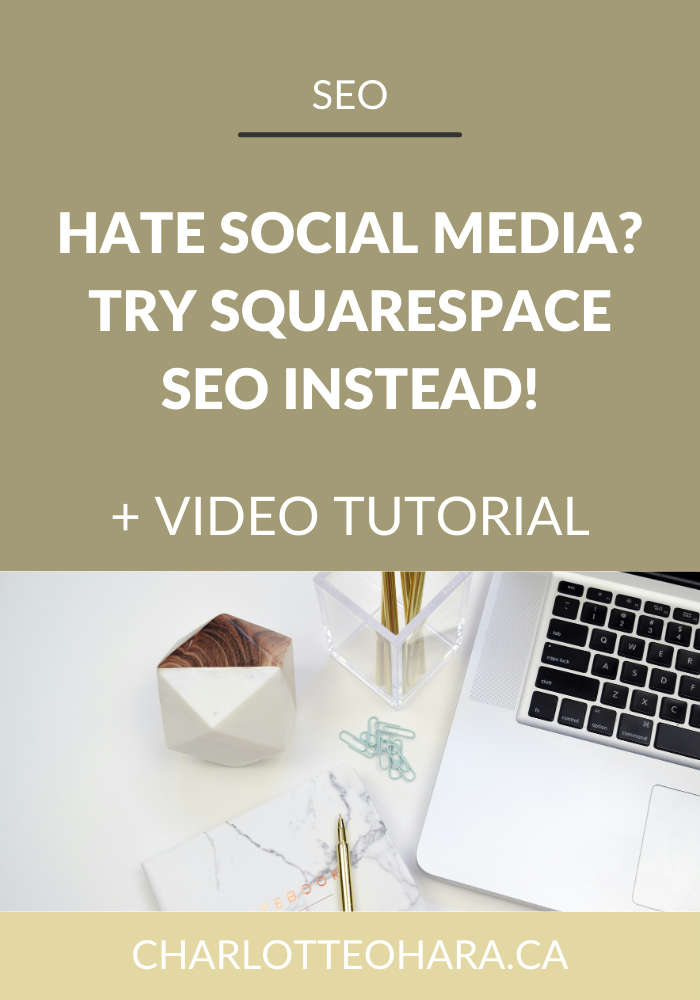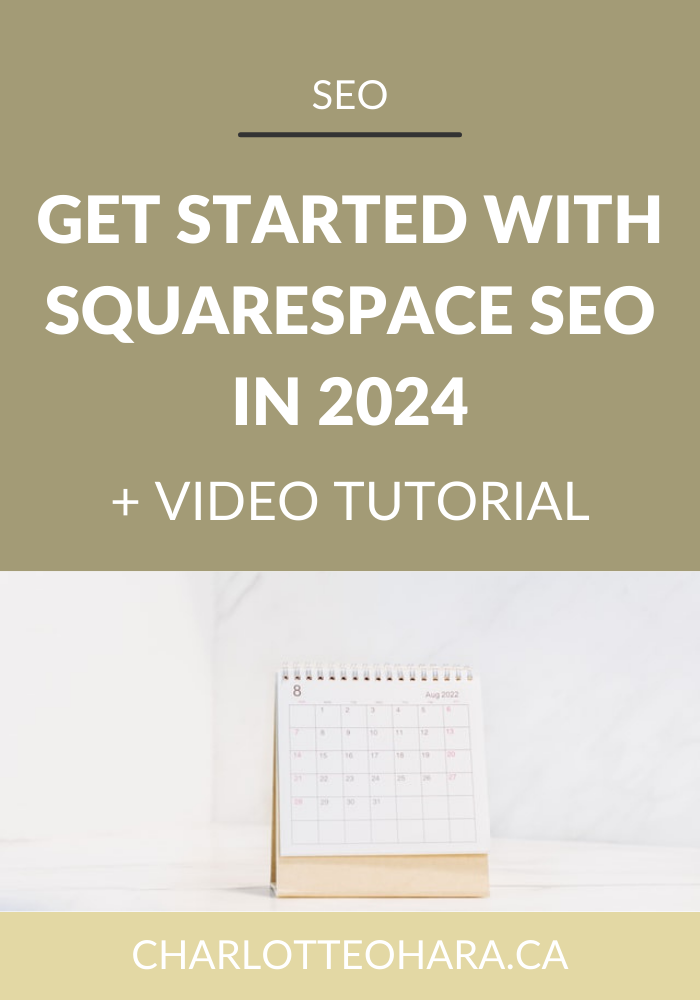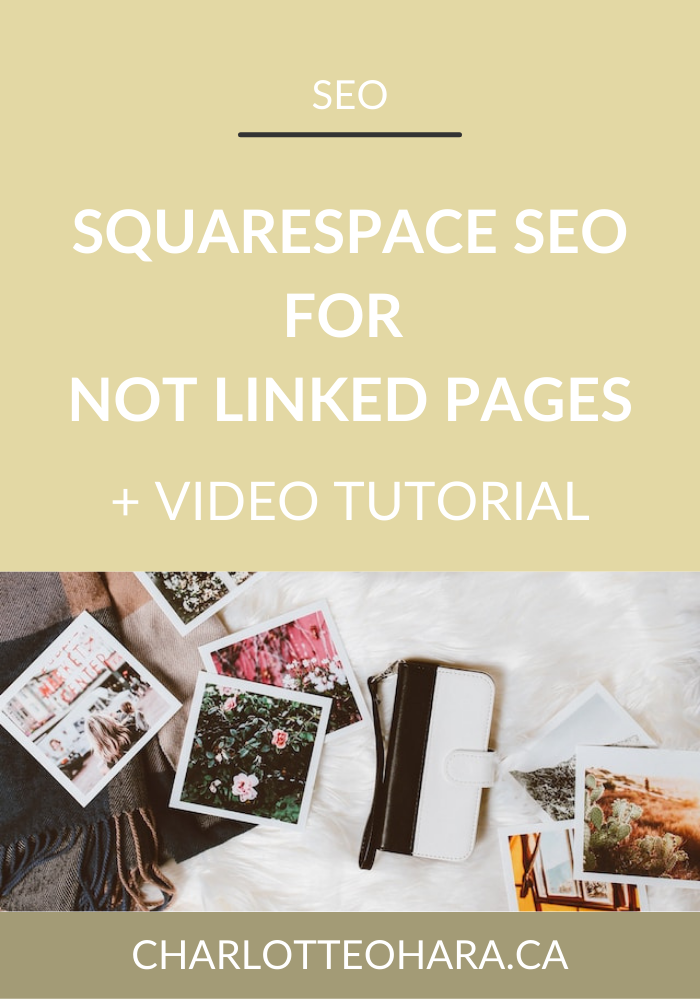The real reason why URL redirects are so important for Squarespace SEO
Gather round, hunnis, for a much-requested topic today about everyone’s favourite topic - Squarespace SEO!
In my ongoing quest to educate the world wide web about Squarespace SEO, I’m coming at you with a brand new lesson/feature/strategy for you to try out on your own website - yippee!
Don’t let the technical term “URL redirect” freak you out - it’s not a scary topic and I know you’ll be pleasantly surprised by how easy they are to set up.
URL redirects are often used to make things simpler and easier for users and visitors who are accessing your website - which makes sense, because we can give them sort and sweet links instead of a crazy long URL slug. People often think about user experience as the first & foremost reason to set up a URL redirect.
But that’s not the only reason why URL redirects are so helpful, useful and effective.
One of my favourite things about URL redirects is how well they can be used from an SEO point of view! That’s right, setting up URL redirects can have some significant SEO effects and may help your website appear higher in search results :)
SEO is hugely valuable because it’s basically free marketing, but that doesn’t mean that it’s easy to master. Honestly, there are so many moving parts and things to keep track of that it’s no wonder people are scared off by those three little letters.
That’s why I’m so keen to share this post and video tutorial with you today so that you can learn all about URL redirects and see how much value they have for SEO.
But before we dive into URL redirects, please make sure that you’re all caught up with my other blog post about URL
If you aren’t totally sure about URL slugs in the first place and you have no clue what a permalink is, please go read this blog post first and then meet us back here when you’re ready:
Remember that SEO is an art, not a science. There’s so much to learn about Squarespace SEO which is why I have written about it a lot - it’s the most popular topic on my blog by far.
SEO can be hella confusing so if you have any questions, you are welcome to leave a comment below and I’ll do my best to respond. I personally work with select consulting and strategy clients every month so if you’re interested in that, please get in touch. I also share SEO tips with my newsletter (which you can sign up for here). Check out my Squarespace SEO page for more resources, blog posts & video tutorials and get your copy of my Squarespace SEO Checklist below for free. Phew!
Sit back, relax, and let’s start tinkering with those links!
SQUARESPACE SEO SERIES
This article is part of my series on Squarespace SEO. I have so many tips to share on the subject that it would have been crazy to put it all in one article! There are many misconceptions about Squarespace SEO which is why I've dedicate so many posts to this topic. Enjoy!
Click to view all posts in the Squarespace SEO Series
Visit my Squarespace SEO page for lots more resources.
We’ve already talked about the importance of URL structure & permalinks for SEO. Now I’m going to give you an insider’s look at how we can take things a step further and make sure that we’re making our website’s URLs even more effective and easier to work with!
Here’s a look at what we’ll cover in this blog post & video tutorial about URL redirects and Squarespace SEO:
What are URL redirects
How URL redirects work
The difference between 301 and 302 redirects
Why you’d want to use URL redirects on your Squarespace website
Why URL redirects are important for Squarespace SEO
How to set them URL redirects on your Squarespace website.
Again, please don’t get intimidated by the term ‘url redirect’ - yes it’s technical but it’s actually super easy to set up and I know you’ll see some major benefits!
Setting up URL redirects on your Squarespace website and why they are so important for SEO
What are URL redirects?
URL redirects forward website visitors away from pages that don't exist to active pages. This can be for permanent changes (which are known as 301 redirects) or temporary changes (aka 302 redirects).
How URL redirects work
URL redirects are basically internet wizardry and they’re a really cool way to make sure that site visitors are accessing content through a functioning and easy to use URL.
With URL redirects, it’s possible to have more than one URL that leads to the same page. Whether someone types the URL in manually or clicks over to it from a link on a website, they’re a great feature that makes sure that people are getting the right content and accessing live pages.
The difference between 301 and 302 redirects
Before we dive too deeply into URL redirects and SEO, you must first understand that there are two types of URL redirects. And depending on your own website needs or situation, you might end up using one or the other - or something both and a combination of the two!
301 redirects are more common than 302 redirects and they’re something that I set up quite regularly with my own clients, on my own website as well as the websites I work on.
301 redirects
301 redirects direct site visitors to a different URL when they click a link to a nonexistent page. These redirects tell search engines (like Google) that a page has moved, and search engines transfer the old page's rank to the new page.
To use a 301 redirect, the original URL can no longer exist, and the new one must exist. Ensure the old URL doesn't exist by deleting the old page, disabling it, or changing its URL.
You should use 301 redirects if:
You changed a page's URL (in its page settings)
You deleted a page from your site and want to redirect to your homepage.
You imported content and the URLs changed. In this scenario, it's usually because your previous site didn't have a page slug for the blog page, just posts.
You're redirecting to another domain.
In my experience, the most common reasons why you’d set up a URL redirect are because you’ve changed a page’s URL slug or because you’ve deleted a page and don’t want visitors to land on dead links.
302 redirects
302 redirects direct visitors to a different URL when someone clicks a link to an old page. They tell search engines that a page has temporarily moved. Search engines don't give the new page the same rank as the old one. Since the redirect is temporary, it lets search engines know that the original page should keep its rankings, as it will be back online.
302 redirects are commonly used when stores or restaurants change their products and offerings seasonally. So if you have an e-commerce shop or something, this might be the type of URL redirect that works best for you.
You should use 302 redirects if:
You need to temporarily take down a page to update it for your new offerings.
You want to temporarily replace a page with another page as you cycle through different offerings through the year.
Why you’d want to set up URL redirects on your Squarespace website
We just went through several reasons why you might set up URL redirects but I’d like to show you a few other “use cases” as well.
1 - Short & sweet & easy to remember links
First off, the number one reason why you might set up URL redirects is so that you have short, easy to remember links.
Compare two websites urls like:
www.myexamplewebsite.com/blog/mastering-rooftop-gardening-on-east-facing-patios
www.myexamplewebsite.com/blog/east
See how much easier and simpler the second URL is? It’s easier to say, easier to type out, looks cleaner on the page, etc.
If you set up a URL redirect, a visitor could access the same blog post whether they use the first URL or the second url.
Here are some examples of situations that you might want to have simple & easy links:
Sales page (e.g., charlotteohara.ca/top-squarespace-seo becomes charlotteohara.ca/tss)
Sharing a link to a podcast episode show notes (e.g., charlotteohara.ca/42)
Webinar or workshop registration page (e.g., charlotteohara.ca/webinar)
Sharing affiliate links (e.g., charlotteohara.ca/companyname
Freebies or opt-in gifts (e.g., charlotteohara.ca/freebie)
Custom social media bio link (e.g., charlotteohara.ca/instagram
E-commerce inventory
Obviously there are many more use cases for URL redirects but this gives you a couple ideas to start with!
2 - They’re better for user experience
This is a big one, mostly from a human or real life person’s point of view - if a URL or link is easier to remember or type out, think about how much easier that is for them to work with!
It will just take a few minutes to set up the URL redirects but they can have a major impact.
Here’s why URL redirects are good for SEO
There’s a number of reasons why URL redirects are beneficial from SEO, from both a technical point of view but also from the more abstract user experience aspect.
The first thing I want you to remember is that search engines like Google are going to crawl your website and click through all the links on your site. If there are any dead links that lead nowhere, you will be penalized for this - this is because dead links are significant a SEO factor because they lead to a poor user experience - people aren’t able to access their desired website content.
Same thing goes for any other websites that are linking to pages on your site where the URL doesn’t work anymore, either because it’s changed or been deleted.
Related: Benefits of backlinks for Squarespace SEO
Let’s imagine that you’ve been tinkering around with your URL slugs to either add in descriptive keywords or to correctly format them, then you might end up with new URL slugs. In this case, the “old” pages won’t work anymore and unless you update the URL redirects, you’ll end up with dead links. Obviously this is very bad for SEO so you want to tighten it up here.
Secondly, any pages that you’ve deleted entirely should be redirected somewhere new, like the homepage or another section of your website. I’ve found this to be a super common occurrence with e-commerce shops where once a product is sold out or discontinued, you don’t want to lose out on that traffic or existing links. So this is a great reason to set up a URL redirect. Same thing goes for services that you might offer on your website - don’t leave people hanging!
URL redirects are also great for SEO because they improve the user experience. Anytime you make it easier for people to interact with your website and access the content they desire, you’re going to repeat the SEO benefits. URL redirects keep people on your site longer (because they aren’t coming up with dead links) and they can directly access the pages/blog posts/products/collections/etc that they desire.
How to set up URL redirects on your Squarespace website
To set up URL redirects on your squarespace website:
From the Home Menu, click Settings, then click Advanced
Click URL Mappings.
Click into the text box and add your redirects.
Click Save.
When you’re setting up these URL redirects, you must ensure that the formatting is set up correctly in order for the redirect to work. I sometimes see problems when people don’t type the URL redirect properly into the text book so here are some suggestions to help you out:
In the text box, in order of left to right, you will:
Type in the tail of your desired short link. (eg. /freebie)
Make an arrow using the dash and greater than symbols. (Here’s what it should look like: ->)
Type in the tail of the actual URL you are directing visitors to. (eg. /squarespace-seo-checklist-freebie-opt-in)
Type in “301"
Also, if you have trouble saving your URL redirects, just try clicking the backspace button or move your cursor so that it’s is on the same line as “301” in your Text box.
Finally, here’s your friendly reminder to test out your new URL redirects before you start sharing them with the world haha!
Final Thoughts
Have I convinced you that URL redirects are nothing to fear? Have you thought of all the ways you can use them on your own website? Are you like, totally hyped and ready to test them out?
I’d love to know so leave me a note in the comments below. If you have any questions about URL redirects and how they relate to Squarespace SEO, I’m only a few taps of the keyboard away so pop your question below and I’ll do my best to answer them.
No matter what type of website you have, it will benefit from SEO so I encourage you to start where you are and work on improving your SEO a little bit every week.
If you want more SEO goodness, be sure to check out my Squarespace SEO page for all resources on the topic.
You can also sign up for my newsletter (right here or below), where I often share Squarespace SEO tips, tricks and high-quality exclusive content. I send out emails to my list every week and while I don’t talk about SEO every time, I can guarantee that you’ll still find the newsletter topics interesting, entertaining and worth your time.
Finally, shameless plug : hit me up with any specific questions you have about Squarespace SEO and your website because I’m your girl. You can reach out to me directly if you’re interested in working together on your website and we can talk about whether or not you would be a good fit for my consulting and ongoing services. I can’t take on every request to do SEO consulting but I do pick a few websites and businesses to work with every month and I’d love for you to be one of them.
You may also be interested in:
Top Squarespace SEO - online course details and enrollment
Squarespace SEO for Affiliate Marketing - masterclass













